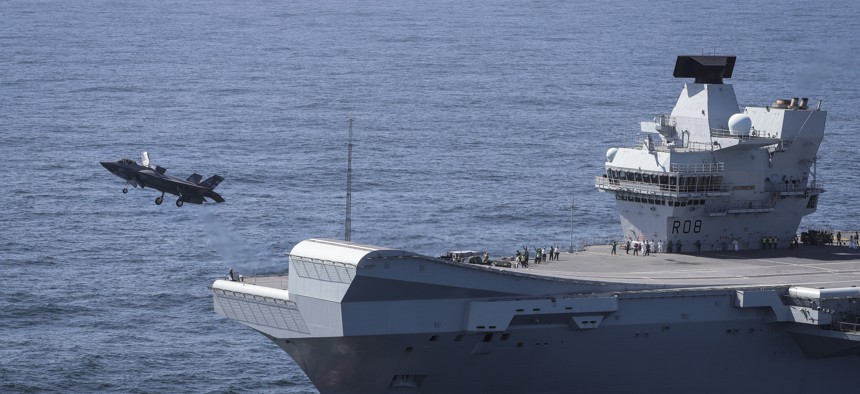
Commander Nathan Gray RN, Makes the first ever F-35B Lightning II jet take off from HMS Queen Elizabeth. UK Ministry of Defence Photo by LPhot Kyle Heller
F-35 Lands on New British Carrier for First Time
The fighter jets are conducting trials with the ship off the U.S. east coast.
ABOARD THE HMS QUEEN ELIZABETH IN THE ATLANTIC OCEAN — The expansive flight deck of the United Kingdom’s newest aircraft carrier is largely empty as it steams along the U.S. coastline on its first deployment.
Two fighter jets, U.S.-made F-35 Joint Strike Fighters, sit waiting to race down the ship’s runway. Unlike American aircraft carriers, which use catapults to launch their warplanes, the Queen Elizabeth has a large ramp — called a ski jump — to help heavy, bomb-laden aircraft leap from the flight deck.
“We’ve come across to the eastern seaboard of the United States to conduct the first developmental test trials with the F-35B,” said Commodore Andrew Betton, commander of the U.K.’s Carrier Strike Group. “It’s the first time, anywhere in the world, that we’ve brought together a fifth-gen fighter with a fifth-gen aircraft carrier. So designed and built from the keel up to support these fifth-gen jets.”
The goal of these F-35 tests is “to establish the initial operating envelope that will let us move forward into operational test next year and thereafter into our first planned operational deployment in 2021,” Betton said.
This week’s tests mark the first time the F-35, or any fighter jet for that matter, have flown from the Queen Elizabeth. Its flight deck has previously played host only to helicopters, like the Merlin AW101s that flew a dozen reporters to the ship as it sailed off New Jersey.
“So this is marrying up the jet with the carrier, because we have not flown the jet from the carrier yet,” said Air Vice-Marshal Harv Smyth, the commanding officer of Number 1 Group, the Royal Air Force headquarters that oversees jet fighters.
“Once we get flight envelope established, that’s the basic aim of this deployment,” said Cmdr. Nath Gray, the Royal Navy test pilot who landed an F-35 on Queen Elizabeth for the first time this week.
“The aircraft handled as expected,” he said. “The interaction between the aircraft and the ship was exactly as expected as we’ve simulated thousands and thousands of times before. And landing on board. There were no surprises. All of the leg work, all of the analysis prior, has all paid off so far.”
These tests that will continue in the coming weeks off the coast of United States are a big deal for the U.K. military. For one, the U.K. has not flown fighter jets from one of its own carriers in about eight years. These tests bring them one step closer to reconstituting a carrier force that can project military power around the world.
“We’re trying to take every opportunity we can to expand our carrier strike group muscle memory,” Betton said. “We used to do this a lot in the U.K. We’ve had a bit of a gap and we’re getting back into the carrier strike business.”
The U.K. retired its Harrier jump jets, known for their ability to take off and land vertically, in 2010, leaving its military without ship-deployable planes.
“We are taking big steps back into that game again,” said Rear Adm. Keith Blount, the head of Royal Navy aviation. “It’s hugely exciting and it should be reassuring to those back home and indeed on this side of the Atlantic.”
The Queen Elizabeth is the largest ship ever operated by the Royal Navy. Something unique about the ship: it has two islands, the forward one for driving the ship and the aft for air traffic control. Both are built around exhaust pipes from the ship's engines below deck.
The sailors on this sparkling-clean ship walk around with pride. Upon stepping off the flight deck, visitors are greeted by a large banner over a stairwell that reads: “Welcome to Britain’s Conventional Deterrent.”
“The U.S. have 11 carriers, we’ll bring two more, to the good guys,” said Capt. Jerry Kyd, the ship’s commanding officer. “That’s how we’re seeing it.”
